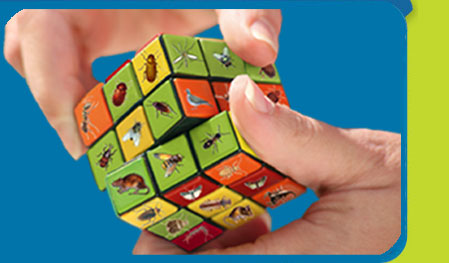Woodworm
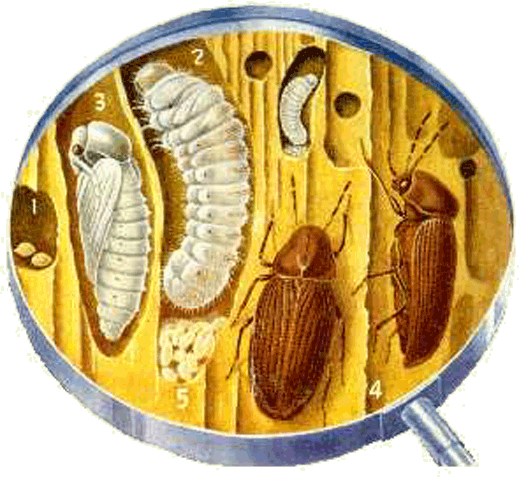
Woodworm is a collective name for several different species of wood boring insects.
These parasitic insects, except for the damage they cause to the environment, they are a real threat to treated and untreated wood.
The infestation is noticeable by holes in the wood and a fine powder.
These insects feed totally on wood substance.
These insects feed totally on wood substance.
They start their lives as eggs, followed by larva stage, transformed in pupa and completing the life cycle later, as adults.
Larvae live in the wood from 1 to 5 years.
This stage is the most destructive for wood, because the insect opens holes and channels in it
1.Anobium Punctatum
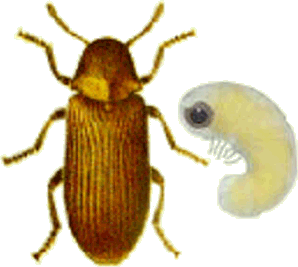 It is the most common insect, infesting wood. It attacks fresh and old wood, usually preferring soft wood. The damage caused, is obvious in floors, furniture, wooden sculptures, wood used in roofs, etc.
It is the most common insect, infesting wood. It attacks fresh and old wood, usually preferring soft wood. The damage caused, is obvious in floors, furniture, wooden sculptures, wood used in roofs, etc.Adult is 3-5mm long and has dull brown colour. We can find it near infested wood or on windows and white surfaces, been attracted there, when temperatures are high.
The holes in wood, produced by the emerging adult, are usually 1.5-2.0mm in diameter. Larva is whitish, up to 6mm long and has three pairs of very small legs. It can destroy infested wood until it becomes pupa, for as long as 3 years. Channels produced in wood are 1.0-2.0mm in diameter.
2. Brunneus Lyctus
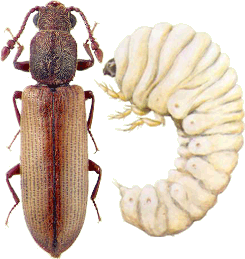 The insects of the family Lyctidae used to be mentioned as ‘LYCTID powder post’. They share the same name with families Anobiidae και Bostrichidae.
The insects of the family Lyctidae used to be mentioned as ‘LYCTID powder post’. They share the same name with families Anobiidae και Bostrichidae.
Lyctid powder posts mostly infest hard wood used in floors, furniture and frames. Larvae are 6mm long and have whitish colour. Larvae open channels in the wood and they become pupae.
Adults are 2-5 mm long and have chestnut red to black colour. Adults’ antennae are short, with flattened ends.
Infestations can be defined by the small round holes in the wood and the presence of fine powder.
 The insects of the family Lyctidae used to be mentioned as ‘LYCTID powder post’. They share the same name with families Anobiidae και Bostrichidae.
The insects of the family Lyctidae used to be mentioned as ‘LYCTID powder post’. They share the same name with families Anobiidae και Bostrichidae. Lyctid powder posts mostly infest hard wood used in floors, furniture and frames. Larvae are 6mm long and have whitish colour. Larvae open channels in the wood and they become pupae.
Adults are 2-5 mm long and have chestnut red to black colour. Adults’ antennae are short, with flattened ends.
Infestations can be defined by the small round holes in the wood and the presence of fine powder.
3.Bajulus Hylotrupes
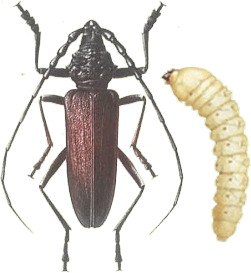 It belongs to Cerambycidae family, a group of Coleoptera insects also known as “European Old Houses Borer”. The main characteristic of this family is the long slender antennae. The adult has black color and is 8-20mm long. It is remarkable that the male is much smaller than the female. Infestation starts from the trees, but it can also be found in treated wood. It infests wood from pine and fir trees. Larva can live in wood from 3 to 10 years, reaching 200mg in weight and causing extended damage. Large oval holes are a sign of the infestation.
It belongs to Cerambycidae family, a group of Coleoptera insects also known as “European Old Houses Borer”. The main characteristic of this family is the long slender antennae. The adult has black color and is 8-20mm long. It is remarkable that the male is much smaller than the female. Infestation starts from the trees, but it can also be found in treated wood. It infests wood from pine and fir trees. Larva can live in wood from 3 to 10 years, reaching 200mg in weight and causing extended damage. Large oval holes are a sign of the infestation.
 It belongs to Cerambycidae family, a group of Coleoptera insects also known as “European Old Houses Borer”. The main characteristic of this family is the long slender antennae. The adult has black color and is 8-20mm long. It is remarkable that the male is much smaller than the female. Infestation starts from the trees, but it can also be found in treated wood. It infests wood from pine and fir trees. Larva can live in wood from 3 to 10 years, reaching 200mg in weight and causing extended damage. Large oval holes are a sign of the infestation.
It belongs to Cerambycidae family, a group of Coleoptera insects also known as “European Old Houses Borer”. The main characteristic of this family is the long slender antennae. The adult has black color and is 8-20mm long. It is remarkable that the male is much smaller than the female. Infestation starts from the trees, but it can also be found in treated wood. It infests wood from pine and fir trees. Larva can live in wood from 3 to 10 years, reaching 200mg in weight and causing extended damage. Large oval holes are a sign of the infestation.
4. Cornutus Bostrychoplites
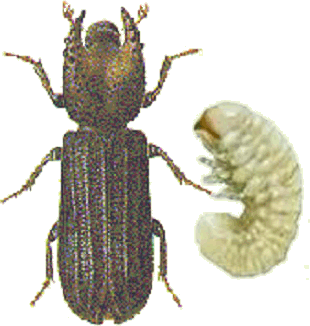 Bostrichids mostly infest tropical hard wood like lauan and maoni. Holes opened in wood are distinctively larger from those opened by other wood eating insects and the produced powder is not carried out, remaining in the channels. They are big insects, normally 7-15mm long, although some are even bigger and have chestnut to black colour.
Bostrichids mostly infest tropical hard wood like lauan and maoni. Holes opened in wood are distinctively larger from those opened by other wood eating insects and the produced powder is not carried out, remaining in the channels. They are big insects, normally 7-15mm long, although some are even bigger and have chestnut to black colour.
Larvae are curved and wrinkled and their feeding depends on the starch in the wood. They prefer wood with moisture from 3 to 30%.
 Bostrichids mostly infest tropical hard wood like lauan and maoni. Holes opened in wood are distinctively larger from those opened by other wood eating insects and the produced powder is not carried out, remaining in the channels. They are big insects, normally 7-15mm long, although some are even bigger and have chestnut to black colour.
Bostrichids mostly infest tropical hard wood like lauan and maoni. Holes opened in wood are distinctively larger from those opened by other wood eating insects and the produced powder is not carried out, remaining in the channels. They are big insects, normally 7-15mm long, although some are even bigger and have chestnut to black colour.Larvae are curved and wrinkled and their feeding depends on the starch in the wood. They prefer wood with moisture from 3 to 30%.
Protection and prevention
- Inspection of all the furniture and the wooden surfaces existing in our homes, once a year.
- Discard of useless and rotten pieces of wood (old furniture, shelves, etc).
- Inspection of all the new coming furniture or wooden material to find out if any wood boring insects are present.
- Inspection of all the furniture and the wooden surfaces existing in our homes, once a year.
- Discard of useless and rotten pieces of wood (old furniture, shelves, etc).
- Inspection of all the new coming furniture or wooden material to find out if any wood boring insects are present.
CONTROL
Control of wood boring insects is achieved by fumigation, using the fumigant phospine. This is the only way and the most effective, to get rid of these insects. But of course, only in cases that gas application is permitted.
Our long experience in this field, may assure a total control, with safety and successfuly.
Control of wood boring insects is achieved by fumigation, using the fumigant phospine. This is the only way and the most effective, to get rid of these insects. But of course, only in cases that gas application is permitted.
Our long experience in this field, may assure a total control, with safety and successfuly.



